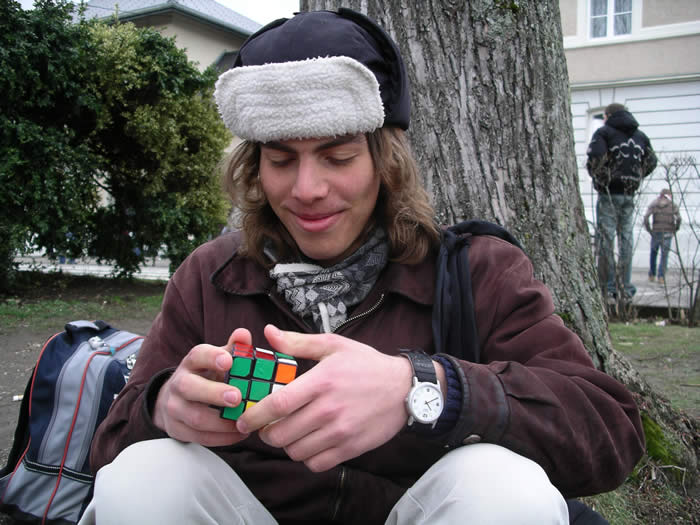
In July of this year Jagmohan Singh, who is being held in a Florida prison on misdemeanor charges, had his hair forcibly cut by prison authorities. Florida’s prison regulations require that hair and beard be cut while a prisoner is in prison and the regulations have been repeatedly upheld on grounds that they serve safety interests. Such regulations disproportionately impact Sikhs and United Sikhs is working to protect Jagmohan Singh (and others) from such discrimination. A few days ago they issued a press release stating that:
UNITED SIKHS’ legal team and religious liberties experts are diligently working on this case, but we need your assistance. Your signatures can make the biggest difference to persuade Florida government officials to take action. UNITED SIKHS calls on all concerned individuals and organizations to sign the petition to save Jagmohan Singh from further trauma and humiliation, and to change the discriminatory Florida prison regulations.
The link to the petition is here.
The sad irony about Jagmohan Singh’s situation is that he narrowly escaped religious persecution under the Taliban in Afghanistan, where Sikhs were not allowed to practice their religion freely under the tyrannical regime. Jagmohan fled to America in 2001 on the basis of religious persecution, only to have his dearest of religious rights violated while serving a sentence for a misdemeanor offense.
Our signatures can make a difference so your activism would be greatly appreciated.
—
Thanks to Dave for sending the link around.
The 300th anniversary of Siri Guru Granth Sahib Ji is being celebrated in an interesting way by dholis in the UK. In 1999, 314 dhol players came together to set a record in the Guinness Book of World Records. This year, in honor of the 300th anniversary, dholfest is trying to set a new record. They’ve registered the event in accordance with Guinness Book of World Records guidelines.
dholfest will be a large outdoor staged event set to break the existing world record of 314 simultaneous dhol players, set in 1999 in Sandwell, West Midlands, UK.
This year we need 500+ players to join us in making this dream come true! [link]
The event is also being dedicated to Ishmeet Singh.
Media XY would like to dedicate this event as a tribute to Ishmeet Singh who was the winner of Star Voice of India. Ishmeet sadly passed away due to drowning in a pool of a resort in Maldives on Tuesday 29 July 2008 aged only 19.
May God give peace and solace to your eternal soul and strength to your loved ones. [link]
Additional info:
The event will take place on Saturday 13th September 2008 in Victoria Square, Birmingham, as part of ArtsFest.
The occasion will mark the celebrations of the 300th Anniversary of the Guru Granth Sahib Ji – as the word Guru. [link]
On Wednesday, August 27, the Delhi High Court sentenced 4 men (Lal Bahadur, Ram Lal, Virender and Surinder Pal Singh) to life in prison, eighteen years after a trial court acquitted them for lack of evidence. The men were charged with rioting, murder, and conspiracy, related to the deaths of Rajinder and Sardool Singh who were burnt alive on November 1, 1984 and their property looted in Sagarpur. The 4 men were also fined Rs. 21,000 each (about $481.43 per person). The High Court stated:
“it is a case where the members of one community were singled out and were murdered and their properties were burnt and looted. Such lawlessness deserved to be sternly dealt with”. [link]
Interestingly, the court found that conspiring to commit a crime was equal to committing the actual crime (I’m assuming that “members of unlawful assembly…in prosecution of the object…” is conspiracy; it’s unclear from the press release whether this is for conspiracy to riot/murder/combination):
“We may observe here that the liability of the members of unlawful assembly who knew that an offence was likely to be committed in prosecution of the object for which they had assembled is equal to those who commit it,” the Bench observed in a judgement on an appeal filed by the state challenging the trial court’s acquittal order. [link] (emphasis added)
 According to a couple of sources, the state appealed the case after the trial court found there wasn’t enough evidence in 1990. If this is true, and not just bad journalism (fabricated facts inserted into the press release), I wish I could congratulate the prosecutors who pursued and won this case.
According to a couple of sources, the state appealed the case after the trial court found there wasn’t enough evidence in 1990. If this is true, and not just bad journalism (fabricated facts inserted into the press release), I wish I could congratulate the prosecutors who pursued and won this case.
A sessions court had earlier on October 31, 1990, acquitted the accused due to lack of evidence. But the state had challenged the judgment in the Delhi high court stating that it have enough evidence to nail the accused persons. [link]
Langa(w)riters have posted on AIDS/HIV infection amongst Sikh women here and here. We have discussed issues around support groups and causes of infection. One of the number one risk factors for contracting HIV/AIDS for Punjabi Sikh women is marriage. Many women are infected by their husbands who are intravenous drug addicts and/or clients of prostitutes. Not only are these women’s lives reaped with more havoc at no fault of their own, but there is also an insurmountable amount of stigma these women endure.
This past week, a Sikh woman, Kiranjit Kaur, stood up with tremendous strength and bravery to help combat this stigma. She become the poster-woman for people living with HIV/AIDS in Malaysia. At the age of 35, Kaur has decided to put her face to this disease because “I am here to help the ‘positive’ community and empower them and tell them they are not alone.”
Kiranjit Kaur contracted HIV in 1996 through her husband who was a former drug addict and has since passed away.
After contracting the disease she began working full-time with the Asian Pacific Council on AIDS Services as an advocate for other HIV/AIDS patients.
 Once again, Indian-Americans have been unwillingly thrust into the heart of a contentious American political battle. For those of you who don’t remember, in 2006, incumbent Senator George Allen singled out and subsequently called an Indian-American, S.R. Sidarth, “macaca” while on the campaign trail. See video here. As The Washington Post’s national political reporter noted, Allen’s use of that slur was a “turning point” in his failed reelection bid, and became “an everlasting part of the political landscape.”
Once again, Indian-Americans have been unwillingly thrust into the heart of a contentious American political battle. For those of you who don’t remember, in 2006, incumbent Senator George Allen singled out and subsequently called an Indian-American, S.R. Sidarth, “macaca” while on the campaign trail. See video here. As The Washington Post’s national political reporter noted, Allen’s use of that slur was a “turning point” in his failed reelection bid, and became “an everlasting part of the political landscape.”
Just a few days ago, presumptive Democratic nominee Barack Obama selected fellow Senator Joe Biden to serve as his running mate. In 2006, Senator Biden said, “In Delaware, the largest growth of population is Indian-Americans, moving from India. You cannot go to a 7-Eleven or a Dunkin’ Donuts unless you have a slight Indian accent.” See video here.
Senator Obama’s decision has generated renewed interest in the 7-Eleven gaffe. See, e.g., here and here. The question is, should we care? In this post, I argue “yes.”
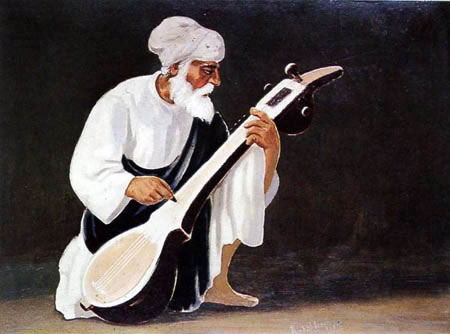 Unfortunately, and perhaps only for myself, I don’t remember the last time I visited one of my local gurdwaras and can say I was moved by the kirtan. Perhaps I feel that most (though not all) kirtan has become modernized to such an extent that it doesn’t really encompass the spiritual enlightenment that shabads were intended to. Actually, it was only after a recent visit to a Namdhari gurdwara that I truly felt that I had heard kirtan in its true element. For those of you who, like myself were unaware, Namdhari Sikhs believe that the only way to reach God is to sing in Raag, the mode of classical Indian music. For Namdhari Sikhs, the instruments they play and the style they sing in is very particular. They place a firm emphasis on rare instruments dating back to the 16th century, the time of Guru Nanak who continued the Vedic tradition of writing the holy scriptures in Raag.
Unfortunately, and perhaps only for myself, I don’t remember the last time I visited one of my local gurdwaras and can say I was moved by the kirtan. Perhaps I feel that most (though not all) kirtan has become modernized to such an extent that it doesn’t really encompass the spiritual enlightenment that shabads were intended to. Actually, it was only after a recent visit to a Namdhari gurdwara that I truly felt that I had heard kirtan in its true element. For those of you who, like myself were unaware, Namdhari Sikhs believe that the only way to reach God is to sing in Raag, the mode of classical Indian music. For Namdhari Sikhs, the instruments they play and the style they sing in is very particular. They place a firm emphasis on rare instruments dating back to the 16th century, the time of Guru Nanak who continued the Vedic tradition of writing the holy scriptures in Raag.
Gurmat Sangeet has always played a significant role in Sikh history and began in the 16th century as the musical expression of divine poetry and yet many of us have never been exposed to this form of kirtan. During our Gurus’ time, Gurmat Sangeet was devotional meditation and music and instruments were used as an accompianment.
Sikh music in the 16th and 17th centuries was comprised of the then-prevalent classical and folk music styles, accompanied by stringed and percussion instruments. The classical style was the devotional dhrupad style, a somber, deeply meditational style in which the text was of prime significance and the music played a supporting, albeit important role in the quest for Divine Essence. Folk music encompassed songs that marked various aspects of life – ghoriaan were sung at marriage, alaahniaan at death, and vaars to glorify brave warriors. [link]
It is said that Raags have a direct relationship to human moods; Soohi representing joy and seperation, Basant representing happiness, and Sarang, sadness. Information from the Sikh Music Heritage Institute states that Guru Nanak began Sikh music with the accompaniment of the rabab, a stringed melodic instrument; Guru Amar Das introduced the stringed instrument, saranda; and Guru Arjan Dev, developed the jori, a two-headed drum. During the 1920s a sharp decline in their use made them almost extinct. The harmonium took the place of stringed instruments and the tabla replaced the pakhaavaj and jori. There are various global efforts taking form to revive classical Sikh music. The Gurmat Sangeet department at Punjabi University, Patiala, the Raj Academy in the UK, and the Sikh Music Heritage Institute in California have dedicated resources to educating and training individuals to play traditional Sikh instruments with the hope that Gurmat Sangeet will be revived.
While those in the diaspora are less likely to follow, many in South Asia have had one eye on the Beijing Olympics and the other looking at the current situation in Kashmir.
This past Friday hundreds of thousands of Kashmiri protestors took to the street calling for ‘azadi’ (freedom) from the tyranny of the Indian state. Viewers in India have looked on in surprise and many different reactions can be found in the Indian press. I will highlight one.
For some more context, Al-Jazeera English has some excellent news analysis. It is a bit lengthy, but well-worth the watch:

A few days ago Sikhnet News posted a story about the Dastarbandi/Pagri di Rasam/Turban Tying Ceremony of Harmanas Singh, a 16 year old young man in California. 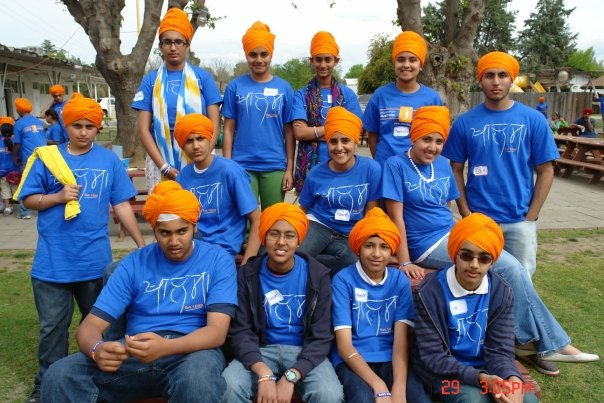 While the story gave only a brief explanation for the ceremony it got me thinking about the significance of the ceremony in the Sikh community in general: why we perform the ceremony, how wide spread it is, and how it pertains today to Sikh women.
While the story gave only a brief explanation for the ceremony it got me thinking about the significance of the ceremony in the Sikh community in general: why we perform the ceremony, how wide spread it is, and how it pertains today to Sikh women.
A couple of websites describe the ceremony like this:
People who have lived in India would know the turban tying ceremony known as Rasam Pagri (Turban Tying Ceremony). This ceremony takes place once a man passes away and his oldest son takes over the family responsibilities by tying turban in front of a large gathering. It signifies that now he has shouldered the responsibility of his father and he is the head of the family. [Source]
The explanation is a bit off –because the ceremony seems more for the passing of personal rather than family responsibility. While there may have been a time when the ceremony signified the passage of family leadership – I think in the Sikh faith the ceremony has come to signify the shouldering of personal responsibility for young Sikhs. The dastarbandi ceremony represents something different for Sikhs – it is as Guru Gobind Singh intended it – a stamp of identity for Sikhs and the responsibilities that being a Sikh entail.
From 7-Elevens to liquor and 99 cents stores, many Panjabi Sikh immigrants build a life for themselves as store workers. Working at these locations gives them a start in America, while engaging with its harsh realities. Regardless of educational background or the pind/shari divide, Panjabi Sikh immigrants work long hours into the night seven days of week trying to build a stable economic future for them and their families. On August 04, 2008, Inderjit Singh Jassal at the age of 62, was one of these Panjabi Sikh immigrants, who was murdered at a 7-11 store during his usual 13-hour shift in Phoenix, Arizona. Jassal had moved to the US nearly 20 years ago, while his wife and two adult children remained in India.
SALDEF reports that:
Mr. Jassal was working at a 7-11 store in West Phoenix when a black male, later identified as 27 year-old Jermaine Canada, walked in with his two children, aged 2 and 6. According to the surveillance video, the two individuals had a short conversation, at the end of which Mr. Canada pulled a concealed firearm from his shirt and fatally shot Mr. Jassal.
The most ironic aspect of this case is that no motive as been found. According to surveillance video there was no angry exchange between Jassal and Canada and nothing was stolen by the murderer.
SALDEF believes that this killing was nothing other than “… a heinous crime motivated by hate”.
According to one of Canada’s relatives, he had a history of drug abuse and mental illness. At the time of the killing, he was under supervised release following 2 years in prison for violating his probation, for a prior dug conviction, with a weapons charge.
Currently, Tajinder Singh Jassal, a nephew of Inderjit Singh Jassal and co-worker, is working to get immigration visas for Inderjit’s wife and children. He is considering sending an appeal letter to Arizona Senator John McCain’s Office for assistance with the visas because “The family is suffering right now. They want to see their father’s face.”
I don’t really know what to make of this, so I won’t even comment. I’ll just let you form your own opinions.
Paramvir Singh Chattwal, of central Hounslow, who claims to be the world’s only Sikh rodeo star after taking up the sport while living in Texas has hung up his spurs for now to track down information about his decorated forefather, who he believes died in or around [Hounslow]. …Paramvir has already spent years researching the life of Risaldar Major Sher Singh Sirdar Bahadoor, who was an original member of the Punjab Frontier Force, formed in 1849. [link]
I’m more interested in Paramvir’s cowboy-ness, than his hunt for his great great grandfather’s legacy, though Paramvir’s view of his ancestor is a bit twisted. Paramvir seems to be equally proud of his cowboy activities, as his grandfather’s fighting for the British in 1857, against his fellow Indians, and also escorting the Kohinoor to become part of the British treasury.
fellow Indians, and also escorting the Kohinoor to become part of the British treasury.
But Paramvir believes [his ancestor] earned his peers’ respect by escorting theKoh-i-noor diamond, then the largest in the world, on a perilous mission across India to Calcutta before it became part of the British Crown Jewels in 1877. “I couldn’t believe he’d been breaking social barriers in 1887 by mixing with the British aristocracy and five generations later I’m doing the same by taking up rodeo,” said Paramvir. (emphasis added) [link]
I’m not trying to promote a tribal mentality (not that that’s a bad thing). But, since when is “mixing with aristocracy” breaking a social barrier?? Slaves “mixed” with their slave owners. Prisoners “mix” with the guards that keep them locked up. Paramvir, you’re confirming my suspicion that all cowboys are stupid, and I really don’t like to generalize. (Ok, one comment.) I hope this article has misquoted you.
Over a year ago, Ajmer Singh Hothi was found shot dead inside a semi-truck that he had just bought and was still making payments on. Only a day before, he had changed his phone number and gotten a restraining order against his ex-girlfriend and her father. [link]
 More information surrounding the case has recently became available since 553 pages of court records from a grand jury hearing have become public.
More information surrounding the case has recently became available since 553 pages of court records from a grand jury hearing have become public.
A prosecutor accuses Gurparkash Khalsa of being driven by humiliation over his daughter’s soiled reputation to the point of ambushing Hothi in a big rig parked east of Stockton. The 56-year-old now sits in a jail cell charged with capital murder… Details of the case recently became public when San Joaquin County Superior Court Judge Charlotte Orcutt unsealed the 553-page transcripts of a four-day grand jury hearing that ended with Khalsa’s April 25 indictment. He was arrested hours later. [link]
The events that led to Ajmer’s death began with a relationship between Hothi and Khalsa’s daughter.
It began in November 2004, when a secret romance sparked between Hothi and Khalsa’s daughter, Kiranjot Pannu, then age 17. The lovers kept it quiet because Hothi was a lowly trucker, while her father owned Pacific Coast Intermodal in French Camp. Hothi’s father, also a trucker, once worked for Khalsa and feared him, according to Hothi’s sister, Kiranjit Hothi, who testified before the grand jury. [link]
Khalsa forbade the romance and Hothi’s parents sent Ajmer to India for an arranged marriage. But then Khalsa heard rumors that Hothi had gotten his daughter pregnant, and that she’d had an abortion. The angry father then demanded that Hothi marry his daughter. He followed Ajmer to India and tried to have him divorced. It seems that he was unsuccessful, and word of his attempt traveled back to Stockton where Khalsa felt humiliated in the eyes of the community. [link]
Guest blogged by Mewa Singh
I did not think I was going to write this post, but after seeing a post on the most popular South Asian American blog – Sepia Mutiny – by Amardeep Singh, I had to make a comment about Musharraf’s resignation to avoid impeachment.
For a quick primer on the career of the Pakistani dictator – Pervez Musharraf, watch the Al-Jazeera video:

Young Sikhs are extremely internet savvy. From the proliferation of videos on youtube to remixed dhadhi-jatha to an embrace of web 2.0, many young Sikhs are at the forefront of creating new avenues for education about their faith. While I personally believe that most Sikhs focus their attention on education for non-Sikhs, in my opinion, far more crucial is the intra-Sikh education.
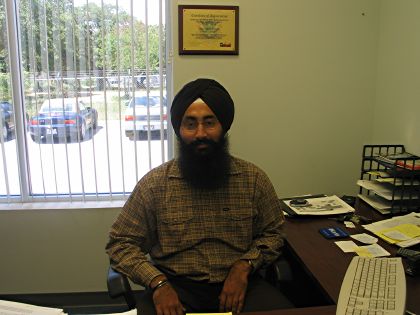 While in an earlier discussion I talked about the importance of the KhalsaKids website, launched last year by the Sikh Coalition. It is an example of Sikhs experimenting with new media forms to better address the needs and concerns of their community.
While in an earlier discussion I talked about the importance of the KhalsaKids website, launched last year by the Sikh Coalition. It is an example of Sikhs experimenting with new media forms to better address the needs and concerns of their community.
In a similar vein, the Sikh Research Institute has recently announced its plans for a “webinar” series, titled “Liv.”
Explaining the impulse of this new project, SikhRI head, Harinder Singh, states:
“We are regularly in touch with Sikh communities in North America, Europe and Asia who want us to deliver programs in their local communities on a regular basis, but it’s been quite difficult due to logistical and financial constraints. Now that we are introducing webinar facilities, our programs can reach anyone around the globe and we look forward to being able to engage with the vast Sikh communities outside of our traditional target area in North America”[link]
The “Liv” project entails four 90 minute seminars to begin at 8am PST (California time) on 4 consecutive Saturdays, beginning September 13, 2008. The first four topics listed on their website includes: “Sikhi – A Gurmat Framework,” “Bani – The Idea,” “Tavarikh (History) – The Revolution,” and “Rahit – The Lifestyle.”
A pre-registration is required to participate in the “webinar” and can be completed here.
While waking up at 8am on Saturdays is beyond my abilities, the seminars being conducted by The Harinder Singh sound intriguing and informative. I hope some of our readers can that do participate can discuss some of their thoughts on the format and the content here.
Also what are new ways that you have seen Sikhs embracing Web 2.0? (yes I am already aware of that one blog, uhhh but I can’t think of the name.)
I remember going to Nagar Kirtans and being awed by those doing Gatka (i.e. Sikh martial arts)! Their “performances” were eye-catching with action, discipline, determination, and spirituality. Watching Gatka helped me connect with Sikh history at a time when there were little resources around me to learn about Sikhi. This martial art gave me some insight into the concept of a “saint-solider” – one who exemplifies Miri/Piri (spiritual/temporal power). I got to see how a saint-solider physically fought to defend Sikhi.
Lately, I have heard people ask, “Is Gatka a “performance” or a “martial art”? I think the “performance” part of the question comes from those who think Gatka is being done more to please crowds than spiritually connect with Sikhi. Also, some think Gatka techniques are being compromised in order for it to be more “safe” for crowd performances? I personally think, Gatka is both a performance and a marital art, but that does not mean spirituality or technique has to be compromised. What do others think?
A recent BBC show on Gatka addressed how it is becoming a way for Diasporic youth to connect to their Sikh heritage, while focusing on physical fitness. It also touches on non-Sikhs participating in Gatka. Let us know what you think!
p.s. I have always found it empowering to see Sikh girls participating in Gatka, even though I rarely see women on Gurdwara management committees!
At one time Punjab Agricultural University (PAU) in Ludhiana, Punjab was THE agricultural university in Asia. Largely due to this university’s role in promoting the Green Revolution (fellow Langa(w)r-iters have described the Green Revolution’s darker sides, another monograph is by Vandana Shiva), students from throughout East Asia came to Ludhiana to study at PAU. In California, I have always been surprised to randomly meet some Chinese men that know Punjabi. However, here is an impressive Malaysian-Chinese man Kian You (AKA Karam Singh) that will leave your mouth wide open. He discusses the importance of continuing the Punjabi language and can even recite the first Pauri of Japji Sahib. On this Friday as many of us tune in to watch the Olympics in China, take a few minutes to watch this video of an ethnically Chinese man teach us about our maboli.
The Sikh Research Institute (SikhRI) reported today that Arpinder Kaur, 28, of San Antonio, Texas has become the first turbaned pilot hired by a commercial airline in the United States. As a Sikhni, she has helped pave the way for both Sikh men and women who wear a dastaar/turban to fulfill their passion for flying. No longer does flying just have to be an extra-curricular activity for these Sikhs, but it can also be an every-day job!
States. As a Sikhni, she has helped pave the way for both Sikh men and women who wear a dastaar/turban to fulfill their passion for flying. No longer does flying just have to be an extra-curricular activity for these Sikhs, but it can also be an every-day job!
In March 2008, after resolving the issue of wearing her dastaar on-the-job, with the help of the Sikh Coalition, Arpinder Kaur was officially hired by American Airlines Corporation (AMR) as a First Officer. She filed her grievance for accommodation of her religious article of faith based on American Airlines’ allowance of “regulation approved hats”. An agreement was reached that is consistent with state and federal anti-discrimination law. In June 2008 she finished her pilot training program and is now flying Embraer Jets for American Eagle, a regional airline that is part of AMR based out of the Dallas-Fort Worth International Airport.
When Arpinder Kaur was asked why she chose to do this, she said:
“Two of the reasons I did this were: first, my love of flying and, second, to set a precedent for the community so they know you can be in your Sikh appearance and do anything out there; so that my younger brothers and sisters [the rising generation] will pursue their passions while practicing their Sikh faith.”
Her passion for flying first started when at the age of 15 she got to sit in the cockpit of an airplane when moving from Panjab. Despite having a degree in Information Systems and her mother’s belief that it was too dangerous for a girl to be a pilot, Kaur has chosen to follow her passion; while using it as a means for supporting her family. Kaur said it was the love and support of her husband, Pritpal Singh that pushed her forward on the path toward becoming a pilot. Kulbir Singh Sandhu, captain with AMR mentored her throughout her aviation career. From 2003 to 2005 Kaur was trained by Jesse Sherwood in Kansas. With the help of these individuals and others along with her own perseverance and determination, Kaur and American Airlines have shown that accommodation and not assimilation is the way to harness the strength of diversity in America.
Harinder Singh, executive director of the Sikh Research Institute (SikhRI) in San Antonio, Texas said, “This is a great day for the Sikhs in America. Religious accommodation, not assimilation, is what the founders of this great nation envisioned and we are thrilled American Airlines celebrates the rich religious and cultural diversity of all American populations.”
Here is a short film on Arpinder Kaur and “piloting”:
While the young Sikh filmmakers are probably preparing for the annual Sikhnet Youth Film Festival (have you seen their ad on satellite television, it is very impressive!), I recently came across some internet announcements for a list of fascinating Canadian-produced short films that I hope will galvanize future discussions.
Although I must confess, at this point, I have NOT seen any of them, still, I wanted to highlight them and hear back from the Langa(r)eaders about their thoughts. Hopefully some of our more vocal Canadian Langa(r)eaders will give us first voice about the films: P.Singh, yes even kaptaan, and others.
Me, Masi, and Mr. Clean
The description from the film’s website is quite poignant:
Eleven year old Seema has issues with her skin colour. Surrounded by the white kids of her community, and inundated by her masi’s (aunt) opinion that fair skin is better, Seema resorts to drastic measures to bleach her skin.
Seema mistakenly believed that using Mr. Clean on her skin will lead to a fairer, more beautiful colour. When Seema ends up in the hospital an unsuspecting character helps her understand skin colour isn’t what defines the person – it’s what’s beneath that counts[link]
Is your mom “chapter president” or a “member” of the local Sikh women’s Sukhmani Sahib club? Many Sikh women (generally those with Auntie status) are commendably coming together to form small groups who go to each other’s homes about once a month to do Sukhmani Sahib da paat to help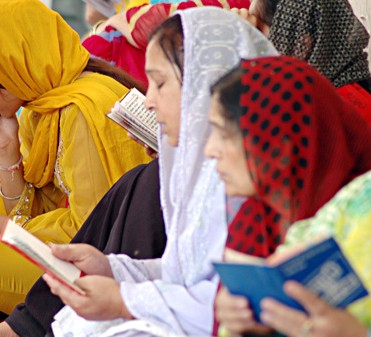 bring/remember peace. Sometimes there is a specific issue a woman’s family is encountering and at other times it just for general familial peace. Thus, our mothers and aunties get to socialize about their everyday lives and connect spiritually through sangat and paat! One of the many things we could learn from them about practicing Sikhi!
bring/remember peace. Sometimes there is a specific issue a woman’s family is encountering and at other times it just for general familial peace. Thus, our mothers and aunties get to socialize about their everyday lives and connect spiritually through sangat and paat! One of the many things we could learn from them about practicing Sikhi!
As International Day of Peace approaches on September 21st, these groups of Sikh women are being asked to come together to recite Sukhmani Sahib da paat. Sukhmani can be defined as counselor of peace or peace of mind with sukh meaning “peace” and mani meaning “mind”, “heart” or “jewel”. The entire paat/poem is known as the “jewel of peace” or “song of peace”. So if your mom belongs to one of these groups or is interested in joining/creating one, please let her know about this day of observance! Now she can do paat to help bring/remember peace in the world along with your well-being!
p.s. It’s always interesting about how many Sikh women are the focal points for spirituality in homes … but that’s another post! 
Everyone seems to be searching for it online. The Langar Hall got it first. So, for those of you that missed the opening ceremonies of the Olympics, here is a picture of the Punjabi Sikh field hockey players on the 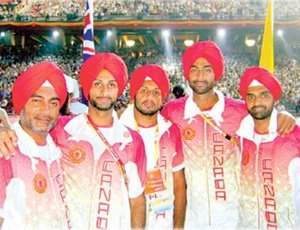 Canadian field hockey team with their pagris (turbans). Pictured from left to right: Assistant Coach Nick Sandhu, Bindi Kullar, Sukhwinder Gabbar Singh, Ravi Kahlon, and Ranjeev Deol.
Canadian field hockey team with their pagris (turbans). Pictured from left to right: Assistant Coach Nick Sandhu, Bindi Kullar, Sukhwinder Gabbar Singh, Ravi Kahlon, and Ranjeev Deol.
For previous coverage of the Canadian Field Hockey Team on The Langar Hall see:
Canadian Field Hockey – individual biographies
Sikhs in the Olympics, Beijing 2008 – for a discussion of their turban-wearing decision
Recent Results:
The team lost their first game against the #1 ranked Australians. They will be playing Pakistan next on Day 5 (Wednesday) at 6am EST. Pakistan lost their first match to Great Britain.
We’ve occasionally, briefly discussed the current French ban in public schools on articles of faith. Recently, the Sikh Coalition invited high school students from all over the world to submit entries into their Diversity Essay Contest on “The Role of Freedom of Religion in the context of Contemporary Society.”
Students were asked to take one of the following two sides on the French Parliament’s ban on conspicuous “religious” articles of faith from public schools:
- If you favor the ban: While engaging with issues faced by communities impacted by the ban, please discuss how France’s conception of secularism (laïcité) can be used to shed light on the ban.
If you oppose the ban: What makes you oppose it? Please outline a strategy through which the international community may be mobilized to force France to repeal the ban.[link]
The first place winner was Casey Friedman, from Alameda, CA whose essay can be viewed here. An excerpt from this winning essay:
“Although Article 10 of the high-minded Declaration of the Rights of Man and the Citizen states explicitly, “No one should be disturbed on account of his opinions, even religious,” and although the Constitution of the Fifth French Republic recognizes the Déclaration as fundamental law (“La Déclaration”), France today finds itself uncomfortably pulled in every possible direction by the forces of religion, popular will, secularism, and natural right.” [link]
This competition seems like a great way to engage youth both in and outside our community in a conversation on freedom of religion.



